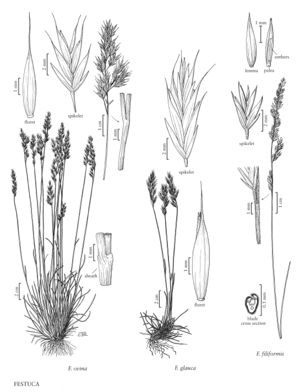Difference between revisions of "Festuca filiformis"
FNA>Volume Importer |
FNA>Volume Importer |
(No difference)
| |
Revision as of 21:20, 16 December 2019
Plants densely cespitose, with¬out rhizomes. Culms 18-40(60) cm, mostly scabrous or puberulent below the inflorescence. Sheaths closed for less than 1/3 their length, smooth or scabrous, glabrous or finely puberulent, persistent; collars glabrous; ligules 0.1-0.4 mm; blades 0.2-0.4(0.6) mm in diameter, conduplicate, abaxial surfaces smooth, adaxial surfaces scabrous, veins 5(7), ribs 1, distinct; abaxial sclerenchyma forming a continuous or almost continuous band; adaxial sclerenchyma absent. Inflorescences 1-6(14) cm, usually contracted, with 1-2 branches per node; branches usually erect, lower branches with 2+ spikelets. Spikelets 3-6(6.5) mm, with 2-6(8) florets. Glumes exceeded by the upper florets, ovate-lanceolate to lanceolate, glabrous; lower glumes 1-2.5 mm; upper glumes (1.7)2-3(3.9) mm; lemmas 2.3-4(4.4) mm, obtuse to acute, mostly smooth and glabrous, sometimes scabrous or pubescent distally, unawned, sometimes mucronate, mucros to 0.4 mm; paleas about as long as the lemmas, intercostal region smooth or scabrous distally; anthers (1)1.5-2.2 mm; ovary apices glabrous. 2n = 14 (28).
Distribution
Wash., D.C, N.H., N.J., N.C., Tenn., N.Y., Pa., Alta., B.C., N.B., Nfld. And Labr., N.S., Ont., P.E.I., Que., R.I., S.C., W.Va., Va., Vt., Ill., Ind., Conn., Maine, Md., Mass., Ohio, Mich., Mont., Wis., Miss., Oreg.
Discussion
Festuca filiformis is a European species that has been introduced to the Flora region as a turf grass. It grows well on poor, dry soils and is becoming a ruderal weed in some areas. It is particularly common in the northeastern United States and southeastern Canada, but has been reported from scattered locations elsewhere.
Selected References
None.
